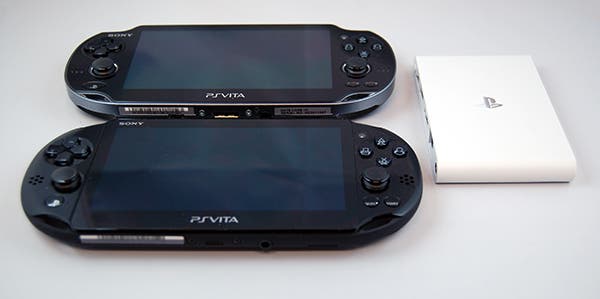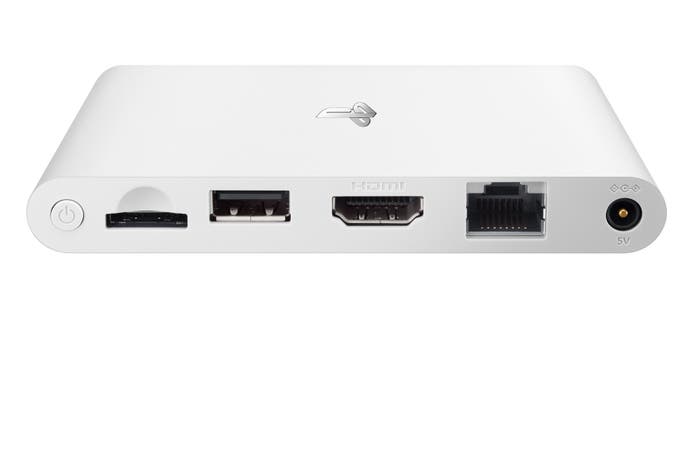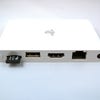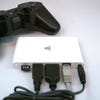Hardware Test: PlayStation Vita TV
Digital Foundry on what it would take to turn a mediocre Japanese launch into a Western hit.
Genius idea, half-baked product, or both? When Vita TV was first revealed on the eve of the Tokyo Game Show, the reaction to the screenless version of Sony's underperforming handheld was uniformly positive. Buoyed by a growing library of quality indie titles in combination with triple-A heavy hitters, this was the micro-console done right: quality hardware, decent games and an excellent controller in the form of the existing DualShock 3. But mediocre sales on the machine's Japanese debut suggest that Vita TV's execution may not have quite lived up to the potential, with much work left to do before the product hits the West.
First impressions of our Japanese import device are wholly positive - perhaps not surprising bearing in mind Sony's legacy of great design and decent build quality. Indeed, nothing quite prepares you for how lovely the micro-console itself actually is - Vita TV is a credit card sized unit, with just enough depth to house an ethernet connection. The hardware is patently well-designed and beautifully constructed with quality matte plastics. The standard kit comes with a multi-voltage 5v power supply, an HDMI cable, and not much else. A more expensive value pack is also available, supplying a DualShock 3 in matching grey plastics, USB cable and 8GB memory card.
Ah yes, the memory cards - the Achilles' heel of the Vita family. As a company, Sony has radically transformed for the better in recent years, but some bad habits are hard to shift. While the world moved on to the standard, cheap MicroSD cards for their mobile storage, Sony hung on to the concept of flogging us overpriced, proprietary memory cards and, unfortunately, they're still here. As standard, Vita TV only comes with 1GB of internal storage - good enough for running cartridge titles and installing a few apps, but woefully short for downloading many games.
Powering up Vita TV is a curious experience as it really is identical to the standard handheld experience, just blown up enormously on your HDTV via HDMI. This is nothing new to those of us who've had hands-on time with a Vita dev kit or a video output modified console - indeed, the HDTV options on the user interface are identical to the tools available to developers: 480p, 720p and 1080i are supported, but the core graphics remain at the standard Vita 960x544 resolution, upscaled in a fairly rough manner. Video content is presented at full 720p, however, while - in theory - the 1080i option should render 1080p streams with little loss of quality on most modern HDTVs.
The most radical difference comes from the way you interact with the system - with touchscreen controls off the table, the DualShock 3 is utilised instead, connecting up exactly as it does with the PlayStation 3. The supplied USB cable hooks up the controller to the micro-console, with just a single press of the PS button pairing the devices. From there you can play wirelessly, just like PS3.
So bearing in mind how many cross-platform triple-A titles are available for Vita, just how well does it measure up as a games console? Well, we've already covered that in depth several months ago with our PS Vita vs. PS3 Face-Off, but there are several key points worth reiterating and expanding upon.
Firstly, you simply cannot underestimate how much the PCH-1000's stunning OLED screen brings to the table - the deep, rich colours work beautifully in tandem with the high pixel density display to produce some stunning results. In fact, the screen is so good that it helps to mitigate some of the problems with sub-native resolution games. Even wobbly frame-rates somehow seem like less of an issue than they should be when you're gaming on a mobile platform.
This changes for the worse with Vita TV. Blown up on a living room HDTV, the compromises become far more evident. Even games running at native 960x544 don't look great, with only titles featuring decent anti-aliasing really holding up well. Sub-native games can look really rough, not complemented at all owing to the two upscaling procedures in place (first up to 960x544, then expanded again to 1280x720). Even on a decent screen, colours can look washed out compared to the OLED experience, resulting in a very bland presentation - even on our well-respected Panasonic VT20 plasma, colour reproduction didn't hold a candle to our treasured PCH-1000 launch Vita.
"Under-selling and under-appreciated in handheld form, a properly handled micro-console transition could revitalise the Vita's fortunes."

| Vita TV | PCH-1000 | PCH-2000 | |
|---|---|---|---|
| Dimensions | 65 x 105 x 13.6mm | 83.5 x 182 x 18.6mm | 85.1 x 183.6 x 15mm |
| Weight | 110g | 260g | 219g |
| Storage | 1GB Onboard/Memory Card/Game Card | Memory Card/Game Card | 1GB Onboard/Memory Card/Game Card |
| Display | HDMI out: 480p/720p/1080i | 5-inch 960x544 OLED | 5-inch 960x544 IPS LCD |
| USB Connectivity | Standard USB | Proprietary | Micro USB |
| Battery Life | - | Around five hours | Around six hours |
There's also a clear compatibility issue too. Any Vita title that relies upon the touchscreen controls is out of bounds on the micro-console, meaning that a vast amount of the platform's library simply can't be accessed. This is a bit of a shame considering how flagship titles like Uncharted: Golden Abyss, WipEout 2048 and Killzone: Mercenary include touch controls almost as an afterthought, but simply won't work on Vita TV. Hopefully we can expect some titles to be patched (Killzone is confirmed, and we hear from Just Add Water that Stranger's Wrath HD may also get TV support) but it's still disappointing that some workaround couldn't be found. The Japanese Vita TV is also region-locked, meaning that whitelisted titles that do work completely fail to boot if you're using non-Japanese cartridges. In fact, Vita TV is a complete non-starter as an import purchase.
It's difficult to avoid the sense that in its current form, Vita TV is a bit of a half-baked product - a good piece of hardware that hasn't quite had as much as thought put into its software as it should have - which may explain the distinctly average sales in Japan so far. It's clear by recent comments from Andrew House that the product is something of a stalking horse for Sony, an exploration in a market that hasn't quite jumped onto the streaming media juggernaut that has powered its way through the US and European markets. For any prospective western launch, Vita TV needs to seriously up its game.
First up, app support needs a major shot in the arm - actual streaming media services you can run on Vita hardware are threadbare at the moment and nowhere near as comprehensive as the Android or Samsung SmartTV offerings. Clearly, Sony should be aiming for parity with those ecosystems, with apps in place at the UK launch for the likes of Lovefilm, iPlayer, 4OD and all the other major services. If Sony really wants to impress, DLNA support would help immensely - but based on PS4's non-support for home streaming, that functionality seems unlikely.
"The Vita's enviable catalogue of top quality games really needs to be exploited more fully for Vita TV - something that is going to require a whole lot of patching..."
Alternative comparisons:
- Stranger's Wrath HD
- Need for Speed: Most Wanted
- Metal Gear Solid 2 HD
- Metal Gear Solid 3 HD
- Virtua Tennis 4
- PlayStation All-Stars
- Sly Cooper: Thieves in Time
Secondly, the Vita's enviable catalogue of games really needs to be exploited more fully - something that is going to require a whole lot of patching, including persuading third-party publishers to update their own titles to work with the new system. We hear from behind the scenes that Sony is pushing Vita TV compatibility to developers and publishers, so hopefully the micro-console will gain more traction from future games, but what a shame it would be if the existing library couldn't be expanded. More realistic pricing on PSP and PS1 titles (both of which should run without issue in most cases on Vita TV) would also be welcome too.
Next up: PS4 Remote Play functionality. In theory this could be a major selling point for the Vita TV because one single PS4 could feed the micro-console running elsewhere in the home. This is a part of the Vita firmware, but it's not available to Vita TV - presumably because PlayStation 4 hasn't been released in Japan. But our tests with a standard Vita suggest that the system isn't really up to scratch right now, with excessive latency clearly impacting the gameplay experience.
"With quality titles like Killzone: Mercenary en route, Vita TV could become the king of the micro-consoles - but better app support and more realistic game-pricing are a must."
In theory, Vita TV could cut down the lag owing to its ethernet connection, making powerline adaptors viable for Remote Play around the home, but our tests strongly suggested that the main area of lag centred on the encoding pipeline within the console - and we're not sure to what extent this can be improved. Certainly, the streamed video is far from pristine and while the small size of the handheld screen mitigates many of the issues, we don't think that upscaling image quality like this to an HDTV will do the system too many favours. The 30fps cap on streamed gameplay is also an issue.
Finally, there's a massive issue surrounding pricing - on both games and the hardware itself. By moving the Vita into the living room, much of the existing library of games looks very, very expensive. Vita TV will be sharing space with the likes of Xbox 360 and PlayStation 3, making those historically expensive cross-platform releases look rather pricey indeed for what are mostly inferior versions. Let's hope that Sony and the third parties appreciate this and move their Vita prices more into line with the premium end of the mobile market. In fairness though, this is already happening to a certain extent on retail carts, where superb games like Virtua Tennis 4 are available from Amazon for just £5.
But it's the cost of the Vita TV itself that will play a key role in determining the success of the system. Unless it's bundled with a DualShock 3, a decently sized memory stick and a bunch of really good games, £99 just feels like too much - uncomfortably close to a £130 entry-level Xbox 360 that is capable of so much more. Vita TV is well made, but it's clearly much, much cheaper to produce than the Microsoft console. Sony's fledgling micro-console really needs to be very affordable and downright indispensable to gain traction. £59.99/$69.99 for the base model, anyone?















